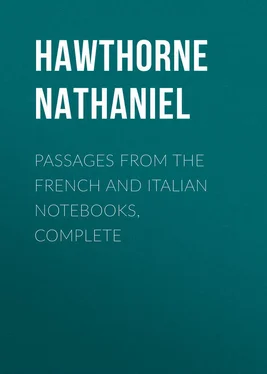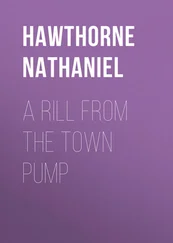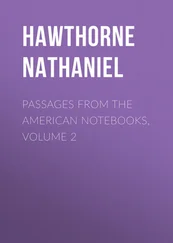Nathaniel Hawthorne - Passages from the French and Italian Notebooks, Complete
Здесь есть возможность читать онлайн «Nathaniel Hawthorne - Passages from the French and Italian Notebooks, Complete» — ознакомительный отрывок электронной книги совершенно бесплатно, а после прочтения отрывка купить полную версию. В некоторых случаях можно слушать аудио, скачать через торрент в формате fb2 и присутствует краткое содержание. Жанр: literature_19, foreign_antique, foreign_prose, на английском языке. Описание произведения, (предисловие) а так же отзывы посетителей доступны на портале библиотеки ЛибКат.
- Название:Passages from the French and Italian Notebooks, Complete
- Автор:
- Жанр:
- Год:неизвестен
- ISBN:нет данных
- Рейтинг книги:5 / 5. Голосов: 1
-
Избранное:Добавить в избранное
- Отзывы:
-
Ваша оценка:
- 100
- 1
- 2
- 3
- 4
- 5
Passages from the French and Italian Notebooks, Complete: краткое содержание, описание и аннотация
Предлагаем к чтению аннотацию, описание, краткое содержание или предисловие (зависит от того, что написал сам автор книги «Passages from the French and Italian Notebooks, Complete»). Если вы не нашли необходимую информацию о книге — напишите в комментариях, мы постараемся отыскать её.
Passages from the French and Italian Notebooks, Complete — читать онлайн ознакомительный отрывок
Ниже представлен текст книги, разбитый по страницам. Система сохранения места последней прочитанной страницы, позволяет с удобством читать онлайн бесплатно книгу «Passages from the French and Italian Notebooks, Complete», без необходимости каждый раз заново искать на чём Вы остановились. Поставьте закладку, и сможете в любой момент перейти на страницу, на которой закончили чтение.
Интервал:
Закладка:
Yesterday I went out betimes, and strayed through some portion of ancient Rome, to the Column of Trajan, to the Forum, thence along the Appian Way; after which I lost myself among the intricacies of the streets, and finally came out at the bridge of St. Angelo. The first observation which a stranger is led to make, in the neighborhood of Roman ruins, is that the inhabitants seem to be strangely addicted to the washing of clothes; for all the precincts of Trajan's Forum, and of the Roman Forum, and wherever else an iron railing affords opportunity to hang them, were whitened with sheets, and other linen and cotton, drying in the sun. It must be that washerwomen burrow among the old temples. The second observation is not quite so favorable to the cleanly character of the modern Romans; indeed, it is so very unfavorable, that I hardly know how to express it. But the fact is, that, through the Forum… and anywhere out of the commonest foot-track and roadway, you must look well to your steps… If you tread beneath the triumphal arch of Titus or Constantine, you had better look downward than upward, whatever be the merit of the sculptures aloft…
After a while the visitant finds himself getting accustomed to this horrible state of things; and the associations of moral sublimity and beauty seem to throw a veil over the physical meannesses to which I allude. Perhaps there is something in the mind of the people of these countries that enables them quite to dissever small ugliness from great sublimity and beauty. They spit upon the glorious pavement of St. Peter's, and wherever else they like; they place paltry-looking wooden confessionals beneath its sublime arches, and ornament them with cheap little colored prints of the crucifixion; they hang tin hearts and other tinsel and trumpery at the gorgeous shrines of the saints, in chapels that are incrusted with gems, or marbles almost as precious; they put pasteboard statues of saints beneath the dome of the Pantheon; in short, they let the sublime and the ridiculous come close together, and are not in the least troubled by the proximity. It must be that their sense of the beautiful is stronger than in the Anglo-Saxon mind, and that it observes only what is fit to gratify it.
To-day, which was bright and cool, my wife and I set forth immediately after breakfast, in search of the Baths of Diocletian, and the church of Santa Maria degl' Angeli. We went too far along the Via di Porta Pia, and after passing by two or three convents, and their high garden walls, and the villa Bonaparte on one side, and the villa Torlonia on the other, at last issued through the city gate. Before us, far away, were the Alban hills, the loftiest of which was absolutely silvered with snow and sunshine, and set in the bluest and brightest of skies. We now retraced our steps to the Fountain of the Termini, where is a ponderous heap of stone, representing Moses striking the rock; a colossal figure, not without a certain enormous might and dignity, though rather too evidently looking his awfullest. This statue was the death of its sculptor, whose heart was broken on account of the ridicule it excited. There are many more absurd aquatic devices in Rome, however, and few better.
We turned into the Piazza de' Termini, the entrance of which is at this fountain; and after some inquiry of the French soldiers, a numerous detachment of whom appear to be quartered in the vicinity, we found our way to the portal of Santa Maria degl' Angeli. The exterior of this church has no pretensions to beauty or majesty, or, indeed, to architectural merit of any kind, or to any architecture whatever; for it looks like a confused pile of ruined brickwork, with a facade resembling half the inner curve of a large oven. No one would imagine that there was a church under that enormous heap of ancient rubbish. But the door admits you into a circular vestibule, once an apartment of Diocletian's Baths, but now a portion of the nave of the church, and surrounded with monumental busts; and thence you pass into what was the central hall; now, with little change, except of detail and ornament, transformed into the body of the church. This space is so lofty, broad, and airy, that the soul forthwith swells out and magnifies itself, for the sake of filling it. It was Michael Angelo who contrived this miracle; and I feel even more grateful to him for rescuing such a noble interior from destruction, than if he had originally built it himself. In the ceiling above, you see the metal fixtures whereon the old Romans hung their lamps; and there are eight gigantic pillars of Egyptian granite, standing as they stood of yore. There is a grand simplicity about the church, more satisfactory than elaborate ornament; but the present pope has paved and adorned one of the large chapels of the transept in very beautiful style, and the pavement of the central part is likewise laid in rich marbles. In the choir there are several pictures, one of which was veiled, as celebrated pictures frequently are in churches. A person, who seemed to be at his devotions, withdrew the veil for us, and we saw a Martyrdom of St. Sebastian, by Domenichino, originally, I believe, painted in fresco in St. Peter's, but since transferred to canvas, and removed hither. Its place at St. Peter's is supplied by a mosaic copy. I was a good deal impressed by this picture, – the dying saint, amid the sorrow of those who loved him, and the fury of his enemies, looking upward, where a company of angels, and Jesus with them, are waiting to welcome him and crown him; and I felt what an influence pictures might have upon the devotional part of our nature. The nailmarks in the hands and feet of Jesus, ineffaceable, even after he had passed into bliss and glory, touched my heart with a sense of his love for us. I think this really a great picture. We walked round the church, looking at other paintings and frescos, but saw no others that greatly interested us. In the vestibule there are monuments to Carlo Maratti and Salvator Rosa, and there is a statue of St. Bruno, by Houdon, which is pronounced to be very fine. I thought it good, but scarcely worthy of vast admiration. Houdon was the sculptor of the first statue of Washington, and of the bust, whence, I suppose, all subsequent statues have been, and will be, mainly modelled.
After emerging from the church, I looked back with wonder at the stack of shapeless old brickwork that hid the splendid interior. I must go there again, and breathe freely in that noble space.
February 20th. – This morning, after breakfast, I walked across the city, making a pretty straight course to the Pantheon, and thence to the bridge of St. Angelo, and to St. Peter's. It had been my purpose to go to the Fontana Paolina; but, finding that the distance was too great, and being weighed down with a Roman lassitude, I concluded to go into St. Peter's. Here I looked at Michael Angelo's Pieta, a representation of the dead Christ, in his mother's lap. Then I strolled round the great church, and find that it continues to grow upon me both in magnitude and beauty, by comparison with the many interiors of sacred edifices which I have lately seen. At times, a single, casual, momentary glimpse of its magnificence gleams upon my soul, as it were, when I happen to glance at arch opening beyond arch, and I am surprised into admiration. I have experienced that a landscape and the sky unfold the deepest beauty in a similar way; not when they are gazed at of set purpose, but when the spectator looks suddenly through a vista, among a crowd of other thoughts. Passing near the confessional for foreigners to-day, I saw a Spaniard, who had just come out of the one devoted to his native tongue, taking leave of his confessor, with an affectionate reverence, which – as well as the benign dignity of the good father – it was good to behold…
I returned home early, in order to go with my wife to the Barberini Palace at two o'clock. We entered through the gateway, through the Via delle Quattro Fontane, passing one or two sentinels; for there is apparently a regiment of dragoons quartered on the ground-floor of the palace; and I stumbled upon a room containing their saddles, the other day, when seeking for Mr. Story's staircase. The entrance to the picture-gallery is by a door on the right hand, affording us a sight of a beautiful spiral staircase, which goes circling upward from the very basement to the very summit of the palace, with a perfectly easy ascent, yet confining its sweep within a moderate compass. We looked up through the interior of the spiral, as through a tube, from the bottom to the top. The pictures are contained in three contiguous rooms of the lower piano, and are few in number, comprising barely half a dozen which I should care to see again, though doubtless all have value in their way. One that attracted our attention was a picture of "Christ disputing with the Doctors," by Albert Duerer, in which was represented the ugliest, most evil-minded, stubborn, pragmatical, and contentious old Jew that ever lived under the law of Moses; and he and the child Jesus were arguing, not only with their tongues, but making hieroglyphics, as it were, by the motion of their hands and fingers. It is a very queer, as well as a very remarkable picture. But we passed hastily by this, and almost all others, being eager to see the two which chiefly make the collection famous, – Raphael's Fornarina, and Guido's portrait of Beatrice Cenci. These were found in the last of the three rooms, and as regards Beatrice Cenci, I might as well not try to say anything; for its spell is indefinable, and the painter has wrought it in a way more like magic than anything else…
Читать дальшеИнтервал:
Закладка:
Похожие книги на «Passages from the French and Italian Notebooks, Complete»
Представляем Вашему вниманию похожие книги на «Passages from the French and Italian Notebooks, Complete» списком для выбора. Мы отобрали схожую по названию и смыслу литературу в надежде предоставить читателям больше вариантов отыскать новые, интересные, ещё непрочитанные произведения.
Обсуждение, отзывы о книге «Passages from the French and Italian Notebooks, Complete» и просто собственные мнения читателей. Оставьте ваши комментарии, напишите, что Вы думаете о произведении, его смысле или главных героях. Укажите что конкретно понравилось, а что нет, и почему Вы так считаете.












